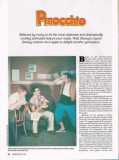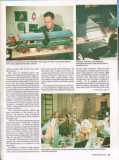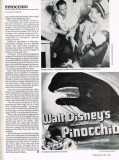Based on the internationally famous 19th century children's classic by Carlo Lorezini (published under the nom de plume of C. Collodi), Pinocchio is a highly moralistic tale of a little wooden puppet who must prove himself worthy of life. Cast in the form of an adventure story, the film includes a veritable who's who of animated characters, including a conscientious cricket named Jiminy, Geppetto the woodcarver, Figaro the cat and Cleo the goldfish. Perhaps no other film is so well remembered for its cast of villains, including: J. Worthington Foulfellow the deceitful fox and his assistant thug Gideon the cat, the brutal puppet master Stromboli, and that terror of the seas, a whale named Monstro.
[img]Charles Judels (the voice of Stromboli and the Coachman) performs for sequence director Wilfred Jackson and animation director Bill Tytla.[/img]
Riding on the unprecedented success of Snow White in 1937, Walt Disney immediately started production on his next animated feature Pinocchio. Almost overnight the studio's animation staff swelled from 300 to nearly 2,000. Woolie Reitherman, one of the animation directors on the film, remembers the excitement at the studio.
"Because of the success of Snow White, we went overboard trying to make Pinocchio the best cartoon feature ever made. We experimented with new techniques, embellished the artwork with tremendous time-consuming detail and modeled the characters to give them roundness and dimension. We even threw out a lot of costly animation, which is something we can't afford to do today."
Milt Kahl, another of the film's animators, remembers the bold experimentation that went into the creation of the film. "We were faced with the problem of how to make a picture better than Snow White, which was incredibly successful. The way to do it was to embellish our animation, and spend money and creative energy like it has never been spent since."
New ways of handling paints and pastels were explored and developed. Innovations in camera operations, lighting, unusual process shots and spectacular animated effects were used. Complex airbrush and dry brush techniques were used for the first time to bring characters to life. Figaro the cat had both dry brush and airbrush work to create a soft furry look.Even Geppetto's hair was dry brushed to eliminate the hard painted edge. Tiny Jiminy Cricket had 27 colors on him (nine is the usual limit today). Cleo the goldfish combined techniques of self-inking lines (ink lines the same color as the paint), transparent paint and subtle "blend" (using a soft waxy crayon on top of the eel) effects.
[img]Sculptor Bob Jones displays the model of Stromboli's tandem gypsy cart. Many of the props and objects in the film were sculpted for the animator's reference.[/img]
[img]Produced in Technicolor, each drawing was photographed through red, green and blue filters on successive frames.[/img]
[img]Both Geppetto's shop and the underwater sequences proved to be special challenges to the Walt Disney sound effects department.[/img]
The multiplane camera, which had been developed at the studio by Ub Iwerks, was used to track characters through extraordinarily finely detailed backgrounds.
"There's a terribly impressive trucking shot at the start of Pinocchio," Reitherman remembers, "in which the camera pans the sleeping village and ducks between buildings and down to the street to focus on Jiminy Cricket. The camera boys were so creative with their angles and use of a dozen planes for a 3-D effect, they ran up a bill of $25,000 for a half-minute shot. That was just for the photography. So, Walt eventually had to blow the whistle and try to conserve on the spending."
In addition to technical and creative improvements over Snow White, Pinocchio revolutionized special animated effects, opening the way for Fantasia. "No one knew how to light a scene with incandescent dewdrops, or how to animate cartoon characters walking on the bottom of the ocean," explains Kahl. "Glowing candles, flickering lamps and modeling on faces to show roundness was all new."
The design for the character of Pinocchio evolved from a rather spindly looking marionette into a slightly chubby and boyisly naive character. There are also remarkable contrasts between the character as he appears in the original 1883 story and the Disney version. In author C. Collodi's tale, Pinocchio is brash and sometimes cruel. He is also constantly in trouble. He is trapped, pursued by assassins and suffers his feet being burnt off among other adventures. What could have been called The Perils of Pinocchio was transformed by Disney into a much simpler and appealing story.
Nevertheless, the Disney version is also remembered for many scenes with powerful characters and sophisticated imagery. The volatile Stromboli, who can bend steel washers in his bare teeth, is a villain of enormous power. Bill Tytla, an animator who created characters of extraordinary power and tenderness, was responsible for Stromboli's dynamic screen presence.
Villainy is everywhere in Pinocchio. Particularly striking are the faceless brutes who pack boys-turned-into-donkeys into crates for shipment — destined to spend their lives as beasts of burden in some salt mine.
And terror. There is the unforgettable image of Pinocchio's friend Lampwick on his knees begging for help as he is rapidly transformed into a donkey. As Lampwick's hands grasp at Pinocchio's shirt, they clutch and are changed into hooves. The shadow of a donkey is seen on the wall, braying and kicking in terror.
Other less terrifying moments seem designed only for adults. For example, after Pinocchio's apparent success as the star of Stromboli's show ("I've Got No Strings"), Jiminy, who has been watching the crowd pour money and adulation on his friend, says: "Well, 1 guess he won't need me anymore. What does an actor want with a conscience anyway?"
When Pinocchio was finished in 1939, Disney was pleased because the critics had unanimously acclaimed Pinocchio superior to Snow White. But the film had cost $2.6 million to make and it would be many years before that cost was repaid.
"We were just coming out of the depression and there wasn't a lot of cash flow," Reitherman recalls. "Yet we spent over two-and-a-half million dollars on it. In those days, we were drawing a weekly salary of $ 15— and that was big money."
Many reasons have been suggested for Pinocchio's lack of immediate financial success. Some of Snow White's instant success was due to its novelty. Also, Snow White was a fairy tale romance, while Pinocchio was basically an adventure story. Indeed, the only female characters are the Blue Fairy and Cleo the goldfish.
But the film has come down to us today as the most elaborate and dramatically exciting animated feature ever made. It has been estimated that it would require a budget of over $25 million if made today. If you have never seen this most magical of Disney animated films or don't remember it very well, now's your chance — look for it in re-release during the Christmas Holidays.
[img]Animators work on J. Worthington Foulfellow's character expressions in this circa 1939 photo.[/img]
[img]An example of early poster art for the film.[/img]


